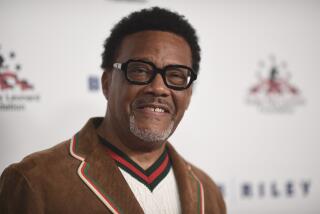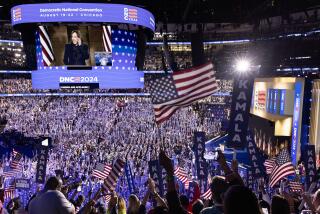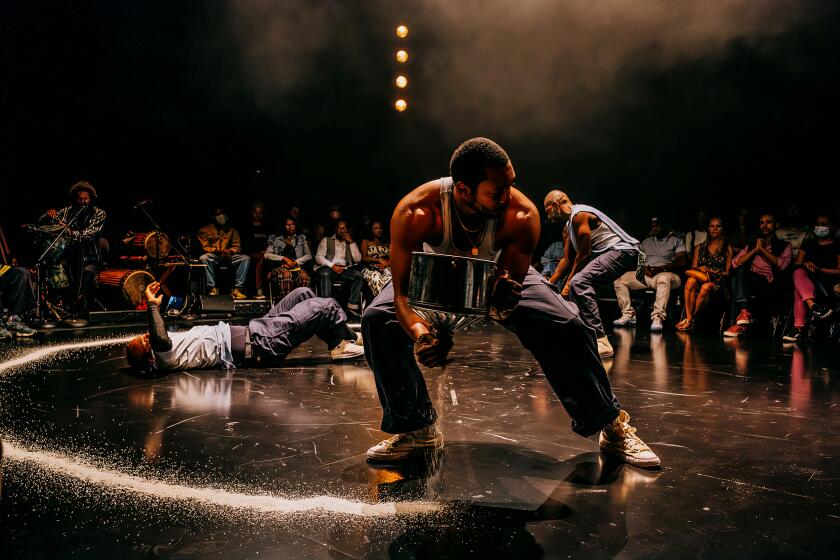SCULPTURE : Sculptor-Designer Noguchi’s Spirit, Range Are Showcased
The spirit of its sculptor-founder is present in even small details at the Isamu Noguchi Garden Museum, an oasis of tranquillity just over the East River, with the Manhattan skyline looming in the background.
On a recent morning visit, art, found art and nature were in harmony. A squirrel hopped unhurriedly across the garden’s gray pebbles, through a group of small, pale boulders lying near “Indian Dancer,” a 5-foot pink granite sculpture.
“Basically, the way you see this is as it was when Noguchi was here,” said museum director Bruce Altshuler.
“These boulders are aji granite--they are the practice pieces stonecutters make, and Noguchi took some of them and put them here.”
Altshuler pointed out another corner of the garden, near a fountain among junipers, birches and bamboos. “Half of Noguchi’s ashes are here, half in Japan,” he said. It’s one of many reminders of the sculptor’s Japanese-American background.
The garden museum, which opened in 1985, has been called one of Noguchi’s last and perhaps greatest works. The sculptor died in New York in 1988, at the age of 84.
(Noguchi’s works include “California Scenario,” near South Coast Plaza in Costa Mesa. The 1.6 acre sandstone courtyard is sandwiched between El Torito Grill and the Bank of the West building.)
At the museum in New York, 12 galleries, rambling over two stories, complement the high-walled garden, with wide windows, doors and corners occasionally open to the sky.
About 300 works are being shown, and many more are in storage, Altshuler said. They are works from all periods of Noguchi’s wide-ranging and influential 60-year artistic career--as sculptor in wood, stone, metal and paper, and as designer of gardens and plazas, stage sets and furniture.
Noguchi acquired a studio opposite the present museum in 1961, Altshuler said. “Then he bought this place, an old photo-engraving factory, and in the early to mid-’70s began to consolidate his sculpture here.”
Another lot was added and the museum building expanded. The space was for storage in the beginning, Altshuler said, “then people began to tell him it was so beautiful, like a museum--so he got the idea and gradually it came about.”
Noguchi was born in 1904 in Los Angeles to an American mother and Japanese father, spent part of his childhood in Japan, then attended schools in this country.
One landmark early in his career came in 1927 when he spent a few months in Paris as assistant to Romanian sculptor Constantin Brancusi. Eventually he returned to New York, where he met and collaborated with choreographer Martha Graham and visionary inventor R. Buckminster Fuller. The three became the greatest influences on his work, Altshuler said.
“The idea of the museum was partly inspired by Brancusi, who always insisted on installing his own work,” Altshuler said. Because of Noguchi’s theories of sculpture in space, the installation of his work was critical for him, too, Altshuler said.
In 1935, Noguchi made the first of many stage designs for Graham. In 1938 he designed his first fountain, for the New York World’s Fair; in 1940 he completed the huge stainless-steel bas-relief, “News,” above the entry of the Associated Press Building in Rockefeller Center.
Among other projects around the world, including his “sculpture of spaces,” Noguchi designed the gardens for UNESCO’S Paris headquarters, the Billy Rose Sculpture Garden in Jerusalem’s Israel Museum and the Horace E. Dodge Fountain in Detroit.
By the end of his life, he was spending six months of each year at his studio home in Mure, Japan, where he did his carving, Altshuler said. New York was the base for his architectural projects.
Some of his late works in granite, basalt and andesite, their dark surfaces shot with rusty tones, dominate a main-floor gallery. Few of these later works have been seen outside the museum.
“For me they culminate his work,” said Altshuler, whose book, “Noguchi,” was recently published by Abbeville.
The rest of the museum’s galleries reflect the sculptor’s wide range. A tour takes one from early biomorphic works in wood and bronze, fragile slate carvings and terra cottas, to brush drawings and other works on paper, models for large-scale landscape sculptures, dance sets, and photographs of works and projects.
There’s also an ethereal group of the famous paper and bamboo Akari lamps, some lit, some not.
“Noguchi considered they had life as sculpture in addition to lighting,” Altshuler said.
The galleries’ style is simple, accommodating pieces in materials ranging from highly polished rose marble to roughly worked granite in which the stone’s own nature remained part of the work. Basically, he left the factory as it was, Altshuler said. “It’s a place of repose, but it still evokes a working place.
“The museum is largely as he left it--the artist’s work as the artist chose to exhibit and install it.”
*
The Isamu Noguchi Garden Museum in New York is open Wednesday, Saturday and Sunday 11 a.m. to 6 p.m., April through November. Admission is by suggested contribution of $4 adults, $2 students and senior citizens. Information: (718) 204-7088.
More to Read
The biggest entertainment stories
Get our big stories about Hollywood, film, television, music, arts, culture and more right in your inbox as soon as they publish.
You may occasionally receive promotional content from the Los Angeles Times.






